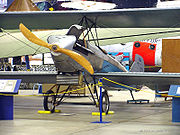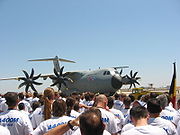
Scimitar propeller
Encyclopedia


Shamshir
A Shamshir also Shamsheer and Chimchir, is a type of sabre with a curve that is considered radical for a sword: 5 to 15 degrees from tip to tip. The name is derived from Persian شمشیر shamshīr, which means "sword"...
, with increasing sweep
Swept wing
A swept wing is a wing planform favored for high subsonic jet speeds first investigated by Germany during the Second World War. Since the introduction of the MiG-15 and North American F-86 which demonstrated a decisive superiority over the slower first generation of straight-wing jet fighters...
along the leading edge. Typically scimitar propeller
Propeller (aircraft)
Aircraft propellers or airscrews convert rotary motion from piston engines or turboprops to provide propulsive force. They may be fixed or variable pitch. Early aircraft propellers were carved by hand from solid or laminated wood with later propellers being constructed from metal...
s are constructed of lightweight or composite material
Composite material
Composite materials, often shortened to composites or called composition materials, are engineered or naturally occurring materials made from two or more constituent materials with significantly different physical or chemical properties which remain separate and distinct at the macroscopic or...
s. In the early 1900s they were made of laminated wood. The combination of light weight and efficient aerodynamics results in more power and reduced noise.

Propfan
A propfan was first defined as a small diameter, highly loaded multiple bladed variable pitch propulsor having swept blades with thin advanced airfoil sections, integrated with a nacelle contoured to retard the airflow through the blades thereby reducing compressibility losses and designed to...
engines use contra-rotating
Contra-rotating propellers
Aircraft equipped with contra-rotating propellers, also referred to as coaxial contra-rotating propellers, apply the maximum power of usually a single piston or turboprop engine to drive two propellers in contra-rotation...
scimitar propellers to achieve turboprop
Turboprop
A turboprop engine is a type of turbine engine which drives an aircraft propeller using a reduction gear.The gas turbine is designed specifically for this application, with almost all of its output being used to drive the propeller...
efficiency levels at high subsonic air speeds comparable to that of turbofan
Turbofan
The turbofan is a type of airbreathing jet engine that is widely used for aircraft propulsion. A turbofan combines two types of engines, the turbo portion which is a conventional gas turbine engine, and the fan, a propeller-like ducted fan...
s.
Turboprops have a fairly narrow sweet spot
Sweet spot
Sweet spot may refer to:*Sweet spot *Sweet spot *Sweet spot...
at speeds below about 450 mph. All propellers lose efficiency at high speed, due to an effect known as wave drag
Wave drag
In aeronautics, wave drag is a component of the drag on aircraft, blade tips and projectiles moving at transonic and supersonic speeds, due to the presence of shock waves. Wave drag is independent of viscous effects.- Overview :...
which occurs just below supersonic
Supersonic
Supersonic speed is a rate of travel of an object that exceeds the speed of sound . For objects traveling in dry air of a temperature of 20 °C this speed is approximately 343 m/s, 1,125 ft/s, 768 mph or 1,235 km/h. Speeds greater than five times the speed of sound are often...
speeds. This powerful form of drag
Drag (physics)
In fluid dynamics, drag refers to forces which act on a solid object in the direction of the relative fluid flow velocity...
exhibits sudden onset, and it led to the concept of a sound barrier
Sound barrier
The sound barrier, in aerodynamics, is the point at which an aircraft moves from transonic to supersonic speed. The term, which occasionally has other meanings, came into use during World War II, when a number of aircraft started to encounter the effects of compressibility, a collection of several...
when it was first encountered in the 1940s. In the case of a propeller, this effect can happen when the prop is spun fast enough that the tips of the prop start traveling near the speed of sound, even if the plane itself is not moving forward.
This can be controlled to some degree by adding more blades to the prop, absorbing more power at a lower rotational speed. This is why some WWII
World War II
World War II, or the Second World War , was a global conflict lasting from 1939 to 1945, involving most of the world's nations—including all of the great powers—eventually forming two opposing military alliances: the Allies and the Axis...
fighters started with two-blade props and were using five-blade designs by the end of the war. The only downside to this approach is that adding blades makes the propeller harder to balance and maintain. At some point, though, the forward speed of the plane combined with the rotational speed of the propeller will once again result in wave drag problems. For most aircraft, this will occur at speeds over about 450 mph.
A method of decreasing wave drag was discovered by German
Germany
Germany , officially the Federal Republic of Germany , is a federal parliamentary republic in Europe. The country consists of 16 states while the capital and largest city is Berlin. Germany covers an area of 357,021 km2 and has a largely temperate seasonal climate...
researchers in WWII: sweeping the wing backward. Today, almost all aircraft designed to fly much above 450 mph (700 km/h) use a swept wing
Swept wing
A swept wing is a wing planform favored for high subsonic jet speeds first investigated by Germany during the Second World War. Since the introduction of the MiG-15 and North American F-86 which demonstrated a decisive superiority over the slower first generation of straight-wing jet fighters...
. In the 1940s, NACA
NACA
- Organizations :* National Advisory Committee for Aeronautics, the forerunner of the U.S. federal agency NASA* National Association for Campus Activities, an organization for programmers of university and college activities...
started researching propellers with similar sweep. Since the inside of the prop is moving more slowly than the outside, the blade becomes progressively more swept toward the outside, leading to a curved shape similar to that of a scimitar
Scimitar
A scimitar is a backsword or sabre with a curved blade, originating in Southwest Asia .The Arabic term saif translates to "sword" in general, but is normally taken to refer to the scimitar type of curved backsword in particular.The curved sword or "scimitar" was widespread throughout the Muslim...
.
.jpg)
Propfan
A propfan was first defined as a small diameter, highly loaded multiple bladed variable pitch propulsor having swept blades with thin advanced airfoil sections, integrated with a nacelle contoured to retard the airflow through the blades thereby reducing compressibility losses and designed to...
concept was intended to deliver 35% better fuel efficiency than contemporary turbofans, and in this they succeeded. In static and air tests on a modified DC-9, propfans reached a 30% improvement. This efficiency comes at a price, as one of the major problems with the propfan is noise
Aircraft noise
Aircraft noise is noise pollution produced by any aircraft or its components, during various phases of a flight: on the ground while parked such as auxiliary power units, while taxiing, on run-up from propeller and jet exhaust, during take off, underneath and lateral to departure and arrival paths,...
, particularly in an era where aircraft are required to comply with increasingly strict FAA noise requirements for certification.

